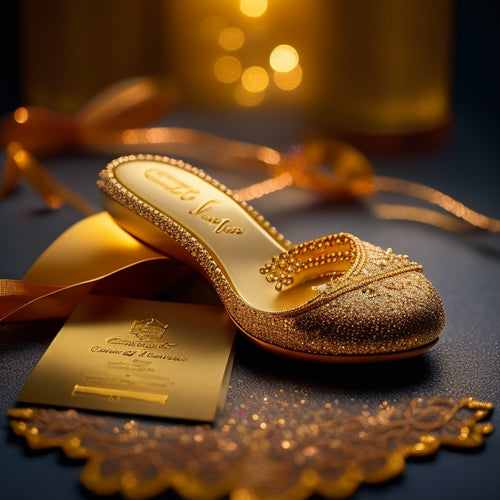
Can You Tap Dance on a Marley Floor?
Share
You can tap dance on a Marley floor, and with proper maintenance and modifications, it can become the perfect surface for mastering your tap techniques and producing rich, resonant sounds. Designed for dance support and traction, Marley floors originated in the 1940s as a shock-absorbing surface. By understanding the essentials of tap dancing, adjusting your shoes, and optimizing the floor for sound quality, you'll be well on your way to creating an unforgettable performance. Now that you've got the basics down, it's time to take your tap dancing skills to the next level - explore how to refine your craft with expert tips and tricks.
Key Takeaways
• Marley floors are specifically designed for dance support and traction, making them suitable for tap dancing.
• Regular maintenance of the Marley floor is crucial to ensure peak performance and safety for dancers.
• The acoustic properties of a well-designed Marley floor can enhance the sound quality of tap dancing.
• Marley floor modifications, such as sprung subfloors and non-slip coatings, can enhance the tap dancing experience.
• With proper maintenance and modifications, a Marley floor can provide the ideal surface for tap dancing.
Understanding Marley Floors
When you step onto a Marley floor, you're standing on a surface specifically designed to provide excellent support and traction for dance movements, thanks to its unique composition and textured surface.
The Marley floor's history dates back to the 1940s, when it was first developed as a durable, shock-absorbing surface for dancers. Today, Marley floors remain a popular choice for dance studios and performance venues.
To maintain peak performance, regular floor maintenance is essential. This includes daily sweeping, weekly mopping, and periodic deep cleaning to remove dirt and grime.
By following these simple steps, you can keep your Marley floor in top condition, providing a safe and supportive surface for dancers to express themselves freely.
With proper care, a Marley floor can last for years, providing a foundation for endless creativity and self-expression.
Tap Dancing Essentials
You're about to bring the Marley floor to life with the rhythmic sounds of tap dancing, where every step, shuffle, and flap counts. As you prepare to tap your way to freedom, remember that tap dancing has a rich history, dating back to African American and Irish dance traditions. Tap dancing offers numerous benefits, including improved coordination, rhythm, and cardiovascular health. To get started, you'll need the right gear and a solid understanding of tap techniques.
| Tap Dancing Essentials | Description |
|---|---|
| Tap Shoes | Metal plates on ball and heel of shoe |
| Tap Techniques | Shuffle, flap, time step, and heel-toe tap |
| Practice Routine | Warm-up, technique drills, and choreography |
| Music Selection | Upbeat jazz, swing, or blues rhythms |
| Tap History | Roots in African American and Irish dance traditions |
Sound Quality on Marley
With every tap, shuffle, and flap, the Marley floor comes alive, and the sound quality of your taps is important to bringing out the rhythmic magic.
As you dance, sound waves are generated, and the floor's acoustics play a significant role in projecting those sounds. A well-designed Marley floor can enhance your tapping experience by allowing sound waves to resonate freely, creating a rich, crisp sound.
The floor's surface, material, and construction all impact the sound quality, so it's crucial to choose a floor that complements your tapping style.
Adjusting Tap Shoes
As you prepare to tap dance on a Marley floor, you'll want to fine-tune your shoes to optimize your performance.
You'll need to adjust the heel counter to stabilize your foot, precisely place the toe taps to produce the desired sound, and make sure the sole plate fits snugly for maximum control.
Heel Counter Adjustment
By the time you're lacing up your tap shoes, you've likely noticed that the heel counter, that sturdy cuff surrounding your heel, needs tweaking to fit snugly and prevent slipping during those intricate rhythms. Adjusting the heel counter is important for a comfortable and secure fit.
Here are some key considerations:
-
Heel height: Make sure the heel counter isn't too high, as this can cause pressure points and discomfort.
-
Counter materials: Opt for breathable materials like leather or mesh to keep your feet cool and dry.
-
Adjustable straps: Look for shoes with adjustable straps to customize the fit and prevent slipping.
- Break-in period: Allow time for the heel counter to mold to your foot shape, ensuring a comfortable fit.
Toe Tap Placement
Now that you've fine-tuned your heel counter, it's time to focus on precision tap placement, and you'll want to pay close attention to the ball of your foot, where the toe taps should be positioned.
This is where the magic happens, and your tap shoes come alive! As you adjust your toe taps, remember to curl your toes to optimize sound quality.
Avoid foot sliding by ensuring a snug fit, allowing you to focus on intricate rhythms and dynamic movements. With each step, you'll feel the freedom to express yourself, and your tap shoes will become an extension of your creative energy.
Sole Plate Fitting
You'll need to adjust your tap shoes' sole plate to fit snugly, ensuring peak sound quality and preventing unwanted noise from loose plates. A secure fit is essential for the best performance and sole protection.
To customize your plate, follow these essential steps:
- Measure your foot to determine the correct plate size and shape for a snug fit.
- Choose the right material for your plate, considering factors like durability and weight.
- Experiment with different plate designs to find the one that suits your tapping style.
- Consider consulting a professional for plate customization to guarantee a perfect fit and excellent sound quality.
Marley Floor Modifications
When transforming a Marley floor for tap dancing, strategically positioning additional sprung subfloors or installing shock-absorbing materials can greatly reduce the impact on your joints. This thoughtful Floor Reinforcement will give you the freedom to dance without worrying about the floor's rigidity.
You can also enhance the floor's Surface Texturing by applying a non-slip coating or adhesive tape to guarantee a secure grip. These modifications will allow you to tap dance with confidence and precision, igniting your creativity and expression.
Performance Tips and Tricks
Your tapping toes are ready to shine with precision and confidence, so master these performance tips and tricks to elevate your tap dancing skills on your newly modified Marley floor.
To take your performance to the next level, focus on:
-
Stage Presence: Own the stage with confidence and charisma, engaging your audience with every step.
-
Musicality: Let the rhythm guide your movements, and experiment with dynamics to add depth to your performance.
-
Visual Connection: Make eye contact with your audience and use facial expressions to convey the emotions of the music.
- Breath Control: Manage your breathing to maintain energy and endurance throughout your performance.
Frequently Asked Questions
Can I Use Outdoor Tap Shoes on a Marley Floor?
As you gear up to tap, remember outdoor shoes aren't designed for indoor Marley floors, so you'll need shoe modification, like adding heels or plates, for perfect harmony, and floor adaptation to prevent damage, ensuring freedom to dance with reckless abandon!
How Do I Prevent Slipping on a Marley Floor?
To prevent slipping on a Marley floor, you'll want to focus on optimizing floor texture, adding heel grips or non-slip coatings, and using shoe adhesives, while maintaining the floor and considering grip strips for maximum traction and freedom of movement.
Can I Practice Tap Dance on a Carpeted Floor First?
'As you prepare to tap dance on a carpeted floor, envision your feet as wings, spreading freedom with every step. Start by evaluating the carpeted surface, ensuring it's suitable for practice, then focus on floor preparations to prevent slipping and injuries, paving the way for a smooth shift to a Marley floor.'
Will a Marley Floor Damage My Tap Shoes?
You'll be thrilled to know that a Marley floor won't excessively wear down your tap shoes, but regular floor maintenance is crucial to prevent damage and promote ideal tap shoe wear.
Can I Use a Marley Floor for Other Dance Styles?
As you soar across the Marley floor, imagine a blank canvas, waiting for your artistic expression! You can absolutely use a Marley floor for other dance styles, like Ballet techniques, Modern expressions, and more, as its smooth surface allows for fluid movements and freedom of expression.
Related Posts
-

Why Stunning Dance Makeup Matters in Photography
When you're capturing the dynamic energy of dance in a single frame, stunning dance makeup isn't just a nicety, it's ...
-

Dazzling Ballet Ticket Unveiled
The anticipation is over, as the dazzling ballet ticket design has finally been revealed, exuding elegance and sophis...
-

Dance Poster Showcases Array of Dance Styles
In addition to showcasing a diverse array of dance styles, dance posters provide a visually engaging tool for cultura...


